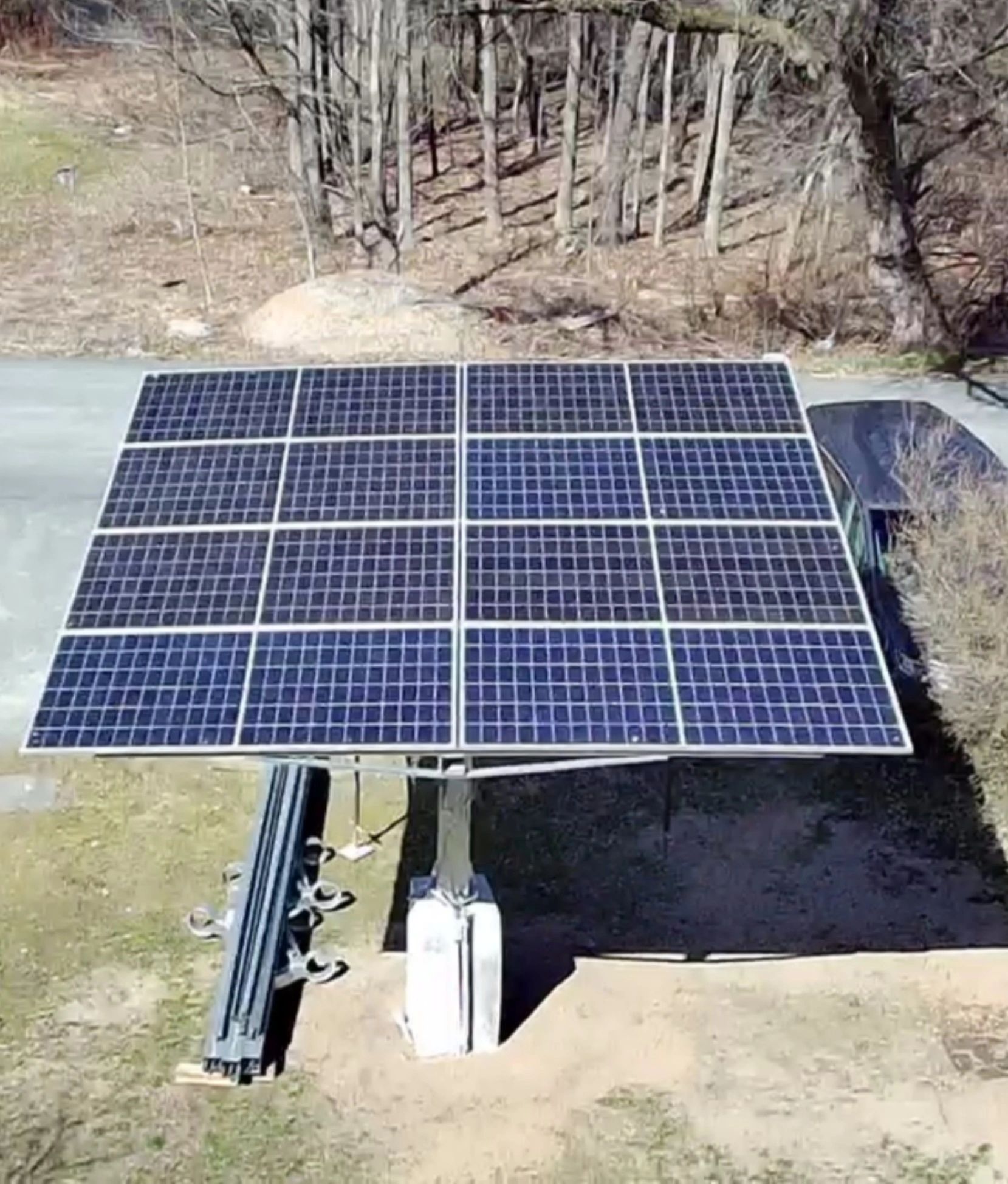Harnessing the Power of the Sun with Solar Trackers
The global push toward renewable energy
sources has prompted many innovations, one of which is the solar tracker. This technology has gained traction in recent years, helping to improve the efficiency and performance of solar energy systems. In simple terms, a solar tracker is a device that adjusts the position of solar panels to face the sun at all times, significantly boosting the amount of energy generated. This article explores how solar trackers work, their benefits, and why they are becoming an essential part of modern solar energy systems.
The Functionality of a Solar Tracker
A solar tracker works by constantly adjusting the angle of solar panels so that they remain perpendicular to the sun’s rays throughout the day. Unlike fixed solar panels, which remain stationary and only capture sunlight at certain times, solar trackers maximize energy production by following the sun’s path. There are two main configurations for solar trackers: single-axis and dual-axis. Single-axis trackers adjust the solar panels along a horizontal axis, while dual-axis trackers offer more precise adjustments, moving both horizontally and vertically.
Types of Solar Trackers
1. Single-Axis Trackers
Single-axis trackers are commonly used in solar energy systems and follow the sun’s movement along a single axis, typically from east to west. These systems are simpler and more affordable than dual-axis trackers but still provide a significant improvement in energy efficiency. Single-axis solar trackers are ideal for regions with clear skies and ample sunlight, where maximizing energy production throughout the day is a priority.
2. Dual-Axis Trackers
Dual-axis trackers, as the name suggests, can adjust both horizontally and vertically, allowing them to follow the sun’s position more accurately. These trackers are typically used in areas where the sun’s position varies significantly throughout the year. Although more expensive than single-axis trackers, dual-axis solar trackers offer the highest energy output and are ideal for large-scale commercial or industrial solar installations.
Key Advantages of Solar Trackers
1. Enhanced Energy Production
The most significant benefit of using a solar tracker is the increased energy production. By following the sun, solar trackers enable solar panels to capture more sunlight, which translates to more electricity generation. This can lead to a 25-35% increase in energy output compared to traditional fixed systems, making solar trackers an attractive option for maximizing solar energy efficiency.
2. Reduced Land Use
In large-scale solar installations, the use of solar trackers can reduce the amount of land needed for the same level of energy output. Since the panels are moving and capturing sunlight more effectively, fewer panels are required to produce the same amount of electricity. This makes solar trackers an efficient solution for areas where land is limited or expensive.
Drawbacks of Solar Trackers
While solar trackers offer many advantages, they are not without their challenges. One of the primary concerns is the higher upfront cost compared to fixed solar panels. Additionally, solar trackers require more maintenance due to their moving parts, and they can be vulnerable to mechanical issues or damage from extreme weather conditions. Despite these challenges, the long-term benefits of increased energy production and efficiency make solar trackers a valuable investment for many solar energy systems.
Conclusion
Solar trackers represent a major leap forward in solar energy technology. By optimizing the angle of solar panels to capture more sunlight, solar trackers can significantly increase the efficiency of solar energy systems. While they come with higher initial costs and maintenance needs, their ability to boost energy production makes them a wise investment for both residential and commercial solar applications. As the demand for renewable energy continues to rise, solar trackers will play a pivotal role in ensuring that solar energy systems are as efficient and effective as possible.
https://howtodiysolar.com/
The global push toward renewable energy
sources has prompted many innovations, one of which is the solar tracker. This technology has gained traction in recent years, helping to improve the efficiency and performance of solar energy systems. In simple terms, a solar tracker is a device that adjusts the position of solar panels to face the sun at all times, significantly boosting the amount of energy generated. This article explores how solar trackers work, their benefits, and why they are becoming an essential part of modern solar energy systems.
The Functionality of a Solar Tracker
A solar tracker works by constantly adjusting the angle of solar panels so that they remain perpendicular to the sun’s rays throughout the day. Unlike fixed solar panels, which remain stationary and only capture sunlight at certain times, solar trackers maximize energy production by following the sun’s path. There are two main configurations for solar trackers: single-axis and dual-axis. Single-axis trackers adjust the solar panels along a horizontal axis, while dual-axis trackers offer more precise adjustments, moving both horizontally and vertically.
Types of Solar Trackers
1. Single-Axis Trackers
Single-axis trackers are commonly used in solar energy systems and follow the sun’s movement along a single axis, typically from east to west. These systems are simpler and more affordable than dual-axis trackers but still provide a significant improvement in energy efficiency. Single-axis solar trackers are ideal for regions with clear skies and ample sunlight, where maximizing energy production throughout the day is a priority.
2. Dual-Axis Trackers
Dual-axis trackers, as the name suggests, can adjust both horizontally and vertically, allowing them to follow the sun’s position more accurately. These trackers are typically used in areas where the sun’s position varies significantly throughout the year. Although more expensive than single-axis trackers, dual-axis solar trackers offer the highest energy output and are ideal for large-scale commercial or industrial solar installations.
Key Advantages of Solar Trackers
1. Enhanced Energy Production
The most significant benefit of using a solar tracker is the increased energy production. By following the sun, solar trackers enable solar panels to capture more sunlight, which translates to more electricity generation. This can lead to a 25-35% increase in energy output compared to traditional fixed systems, making solar trackers an attractive option for maximizing solar energy efficiency.
2. Reduced Land Use
In large-scale solar installations, the use of solar trackers can reduce the amount of land needed for the same level of energy output. Since the panels are moving and capturing sunlight more effectively, fewer panels are required to produce the same amount of electricity. This makes solar trackers an efficient solution for areas where land is limited or expensive.
Drawbacks of Solar Trackers
While solar trackers offer many advantages, they are not without their challenges. One of the primary concerns is the higher upfront cost compared to fixed solar panels. Additionally, solar trackers require more maintenance due to their moving parts, and they can be vulnerable to mechanical issues or damage from extreme weather conditions. Despite these challenges, the long-term benefits of increased energy production and efficiency make solar trackers a valuable investment for many solar energy systems.
Conclusion
Solar trackers represent a major leap forward in solar energy technology. By optimizing the angle of solar panels to capture more sunlight, solar trackers can significantly increase the efficiency of solar energy systems. While they come with higher initial costs and maintenance needs, their ability to boost energy production makes them a wise investment for both residential and commercial solar applications. As the demand for renewable energy continues to rise, solar trackers will play a pivotal role in ensuring that solar energy systems are as efficient and effective as possible.
https://howtodiysolar.com/
Harnessing the Power of the Sun with Solar Trackers
The global push toward renewable energy
sources has prompted many innovations, one of which is the solar tracker. This technology has gained traction in recent years, helping to improve the efficiency and performance of solar energy systems. In simple terms, a solar tracker is a device that adjusts the position of solar panels to face the sun at all times, significantly boosting the amount of energy generated. This article explores how solar trackers work, their benefits, and why they are becoming an essential part of modern solar energy systems.
The Functionality of a Solar Tracker
A solar tracker works by constantly adjusting the angle of solar panels so that they remain perpendicular to the sun’s rays throughout the day. Unlike fixed solar panels, which remain stationary and only capture sunlight at certain times, solar trackers maximize energy production by following the sun’s path. There are two main configurations for solar trackers: single-axis and dual-axis. Single-axis trackers adjust the solar panels along a horizontal axis, while dual-axis trackers offer more precise adjustments, moving both horizontally and vertically.
Types of Solar Trackers
1. Single-Axis Trackers
Single-axis trackers are commonly used in solar energy systems and follow the sun’s movement along a single axis, typically from east to west. These systems are simpler and more affordable than dual-axis trackers but still provide a significant improvement in energy efficiency. Single-axis solar trackers are ideal for regions with clear skies and ample sunlight, where maximizing energy production throughout the day is a priority.
2. Dual-Axis Trackers
Dual-axis trackers, as the name suggests, can adjust both horizontally and vertically, allowing them to follow the sun’s position more accurately. These trackers are typically used in areas where the sun’s position varies significantly throughout the year. Although more expensive than single-axis trackers, dual-axis solar trackers offer the highest energy output and are ideal for large-scale commercial or industrial solar installations.
Key Advantages of Solar Trackers
1. Enhanced Energy Production
The most significant benefit of using a solar tracker is the increased energy production. By following the sun, solar trackers enable solar panels to capture more sunlight, which translates to more electricity generation. This can lead to a 25-35% increase in energy output compared to traditional fixed systems, making solar trackers an attractive option for maximizing solar energy efficiency.
2. Reduced Land Use
In large-scale solar installations, the use of solar trackers can reduce the amount of land needed for the same level of energy output. Since the panels are moving and capturing sunlight more effectively, fewer panels are required to produce the same amount of electricity. This makes solar trackers an efficient solution for areas where land is limited or expensive.
Drawbacks of Solar Trackers
While solar trackers offer many advantages, they are not without their challenges. One of the primary concerns is the higher upfront cost compared to fixed solar panels. Additionally, solar trackers require more maintenance due to their moving parts, and they can be vulnerable to mechanical issues or damage from extreme weather conditions. Despite these challenges, the long-term benefits of increased energy production and efficiency make solar trackers a valuable investment for many solar energy systems.
Conclusion
Solar trackers represent a major leap forward in solar energy technology. By optimizing the angle of solar panels to capture more sunlight, solar trackers can significantly increase the efficiency of solar energy systems. While they come with higher initial costs and maintenance needs, their ability to boost energy production makes them a wise investment for both residential and commercial solar applications. As the demand for renewable energy continues to rise, solar trackers will play a pivotal role in ensuring that solar energy systems are as efficient and effective as possible.
https://howtodiysolar.com/
0 Comments
·0 Shares
·57 Views
·0 Reviews




